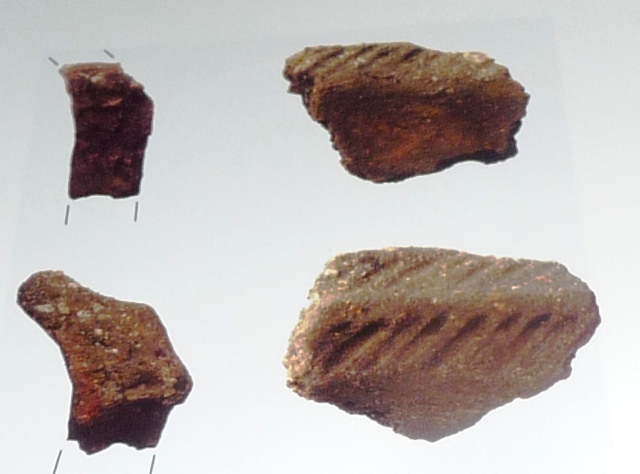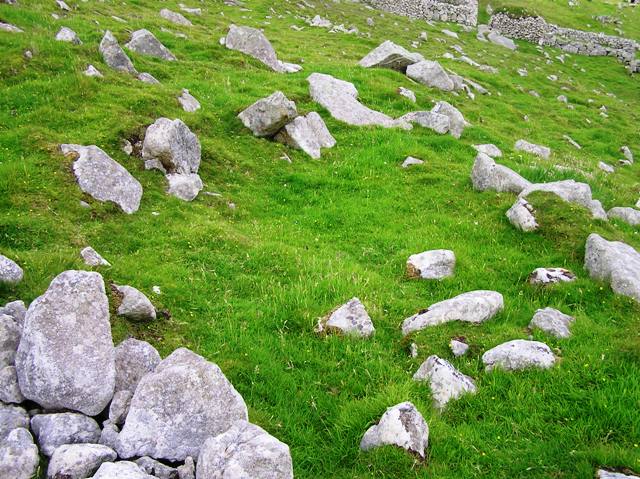
Sherds of pottery found near Tobar Childa.

Sherds of pottery found near Tobar Childa.

Hut Circle NF10099948, looking over the hut circle towards the soon to be replaced army base.

Hut Circle NF10099948. North east and cleits everywhere. Amazingly good dry stane dyking in these parts.

Hut Circle NF10099948. Inside looking north east.

Hut Circle NF10099948 Outer bank north west side.

Hut Circle NF10039958, looking towards the army base, Hirta Bay and Bioda Mor, home to the dun that oversees the entry to the bay. Ancient houses, old houses, army houses and the boats.

Hut Circle NF09959955

Hut Circle NF10039958

Hut Circle NF09959955

Hut Circle NF09959955

Hut Circle NF09959955

Hut Circle NF10039958
After the life changing events at the Lover’s Stone it was time to make our way via the wall/path to the tarred road. It was either head further uphill heading north east or head downhill and east towards the village, not Hirta but the Iron Age hut circles of Tobar Childa. We headed towards Tobar Childa as time was running out as we needed to be back at the pier.
So downhill we headed which enabled us to see the absolutely stunning views again. The weather had started to get even warmer, unbelievable considering the tales of bad weather we’d been told about. Just to the south of the Abhainn Mhor burn we headed straight east to the hut circles. These are hard to find because of the sheer amount of gray rock lying about, they certainly had no shortage of building material. I remained to look for the ancient village whilst A headed to the pier.
NF09959955
This appeared to be a group of 4 hut circles the best of which I photographed. The hut had large stones surrounding its edge and is about 4m in diameter. Harsh place to live during winter possibly, however a lot of people told us that the climate wasn’t so remote and the islands weren’t so isolated as they were to become.
NF10039958
This group seemed to have the best built hut circle making use of a depression, perhaps man made, on which to build their wall. Almost all the hut circles in these groups are about 4m in diameter and this was no exception.
NF10099948
This was to be last stop on mainland St Kilda as A was shouting (probably louder than that) from the Main Street that people were assembling at the pier. NF10099948 had the largest of the surrounding walls. These were almost 1.5m wide and almost 0.75 tall.
Sadly two hut circle groups missed but I’ll visit them the next time we’re here. With that it was a mad dash through various cleits, enclosures, houses (ancient and more modern) and walls to the eastern end of Main Street.
Visited 2/9/2017.
Tobair na h-oige
An old story told in previous centuries by the indigenous folk of Hirta (St. Kilda) described a long-lost well that was thought to be an abode of the little people, known as the Well of Eternal Youth. Not to be confused with the Well of Virtues near the Amazon’s House less than a mile west, the rough whereabouts of this site is cited by J. Sands (1878) in the folklore section of his otherwise historical account on these faraway Atlantic islands. He wrote:
“Once on a time an old fellow, in going up Connagher with a sheep on his back, observed a Well which he had never seen or heard of before. The water looked like cream, and was so tempting, that he knelt down and took a hearty drink. To his surprise all the infirmities of age immediately left him, and all the vigour and activity of youth returned. He laid down the sheep to mark the spot, and ran down the hill to tell his neighbours. But when he came up again neither sheep nor well were to be found, nor has any one been able to find the Tobair na h-oige to this day. Some say that if he had left a small bit of iron at the well—a brog with a tacket in it would have done quite well—the fairies would have been unable to take back their gift.”
Mrs Banks’ Scottish Calendar Customs (1937)
A nearby but long vanished sacred well.
Macaulay, in his “History of St. Kilda” published in 1764, describes a spring there called by the inhabitants Toberi-Clerich, the cleric in question being, according to him, Columba. “This welI,” he says, “is below the village, . . . and gushes out like a torrent from the face of a rock. At every full tide the sea overflows it, but how soon that ebbs away, nothing can be fresher or sweeter than the water. It was natural enough for the St. Kildians to imagine that so extraordinary a phenomenon must have been the effect of some supernatural cause, and one of their teachers would have probably assured them that Columba, the great saint of their island and a mighty worker of miracles, had destroyed the influence which, according to the established laws of nature, the sea should have had on that water,” This spring resembles one in the parish of Tain, in Ross-shire, known as St. Mary’s Well. The latter is covered several hours each day by the sea, but when the tide retires its fresh, sweet water gushes forth again.
MacAulay The History of St Kilda 1764








